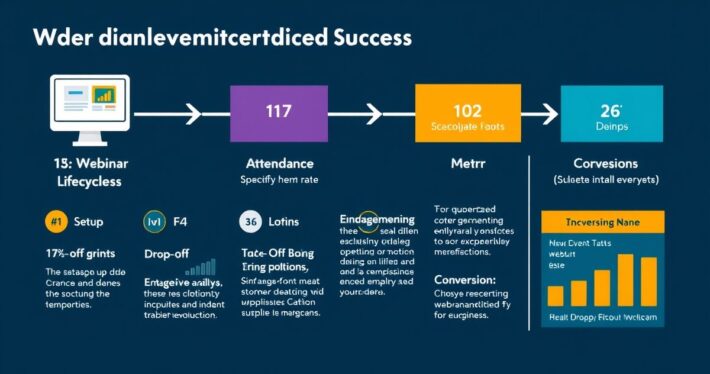How to predict webinar trends and stay ahead of the competition.

How to Predict Webinar Trends and Stay Ahead of the Competition
Webinars have become a cornerstone of digital marketing, offering unparalleled engagement and conversion opportunities. But let’s be honest: the landscape is getting crowded. With so many brands vying for attention, how do you stay ahead of the curve? The secret lies in predicting webinar trends before they go mainstream. In this guide, we’ll explore actionable strategies to identify emerging trends, leverage AI-powered tools, and create webinars that consistently outperform the competition.
Why Predicting Webinar Trends Matters
Think about it: Why do some webinars go viral while others flop? Often, it’s because the successful ones tap into what audiences want before they even know they want it. Predicting trends isn’t just about staying relevant—it’s about positioning yourself as a thought leader. When you anticipate what’s next, you can craft content that feels fresh, valuable, and ahead of the curve.
For instance, during the early days of remote work, brands that quickly pivoted to webinars about productivity tools or mental health saw massive engagement. Those who waited? They missed the boat. The lesson? Timing is everything.
5 Strategies to Predict Webinar Trends
Now, here’s where it gets interesting. Predicting trends isn’t pure guesswork—it’s a mix of data analysis, market observation, and intuition. Let’s break it down.
1. Leverage AI-Powered Insights
AI isn’t just a buzzword—it’s your secret weapon for trend prediction. Tools like our Slide Outline Creator analyze audience behavior, keyword searches, and engagement metrics to identify what topics are gaining traction. For example, if you notice a spike in searches for “AI for small businesses,” that’s a clear signal to create a webinar around that theme.
But wait, there’s more. Our Webinar Offer Builder can help you structure your pricing and value proposition to align with emerging trends. Imagine offering a bonus package tailored to the latest industry pain points—your audience will see you as the go-to expert.
2. Monitor Industry Conversations
What are people talking about in your niche? Forums like Reddit, LinkedIn groups, and industry-specific communities are goldmines for trend insights. For instance, if you’re in the fitness industry and notice debates about the benefits of virtual training, that’s your cue to create a webinar addressing those questions.
Pro tip: Use tools like Google Trends or social listening platforms to track recurring themes and sentiments.
3. Analyze Competitor Webinars
You don’t have to reinvent the wheel. Take a closer look at what your competitors are doing. What topics are they covering? What formats are they using? If you notice a pattern—like interactive Q&A sessions or gamified webinars—consider how you can do it better.
For example, one of our clients noticed a competitor’s webinar on sustainable packaging trends. Instead of copying the idea, they used our High-Value Bonus Brainstormer to create a bonus guide on cost-effective sustainable solutions. The result? A 35% higher conversion rate.
4. Stay Updated on Technology
Webinar platforms are constantly evolving. New features like augmented reality (AR) integrations or AI-driven personalization can transform your webinars from ordinary to extraordinary. For instance, using AI to generate dynamic risk-reversal guarantees (thanks to our Risk-Reversal/Guarantee Generator) can make your audience feel safer saying “yes.”
Don’t ignore the tech—it’s often a precursor to broader trends.
5. Listen to Your Audience
Your audience is your best trend predictor. Pay attention to their questions, feedback, and pain points. Are they asking for more case studies? Do they want shorter, more focused webinars? Use surveys, polls, and post-webinar feedback to gather insights.
For example, one attendee’s question about time management tools sparked an entire webinar series for one of our clients. The series became their most profitable campaign to date.
Real-World Example: Tapping into the AI Boom
Let’s dive into a case study. When AI tools like ChatGPT started gaining traction, many brands hesitated. But one of our clients saw an opportunity. They used our Slide Outline Creator to develop a webinar titled “AI for Entrepreneurs: Transforming Your Business in 2023.”
The webinar wasn’t just about explaining AI—it was about showing how entrepreneurs could use it to save time, reduce costs, and scale their businesses. They stacked the offer with a high-value bonus: a checklist for implementing AI tools in under a week.
The result? A 40% increase in registrations and a 25% boost in sales compared to their previous webinars.
Challenges and How to Overcome Them
Predicting trends isn’t without its challenges. Here are a few common pitfalls and how to navigate them:
- Overloading your audience with trends: Don’t try to cover every trend—focus on the ones most relevant to your audience.
- Failing to differentiate: Just because everyone is talking about a topic doesn’t mean you should copy them. Use tools like our Webinar Offer Builder to create unique value propositions.
- Ignoring feedback: Trends come and go, but your audience’s needs remain consistent. Always tie your webinar content back to their pain points.
Final Thoughts
Predicting webinar trends is both an art and a science. By leveraging AI tools, monitoring industry conversations, and listening to your audience, you can stay ahead of the competition and create webinars that resonate.
Here’s a question to ponder: What’s the one trend you’ve been hesitant to explore, and how can you make it your own? Start experimenting, and you might just discover your next big success.


